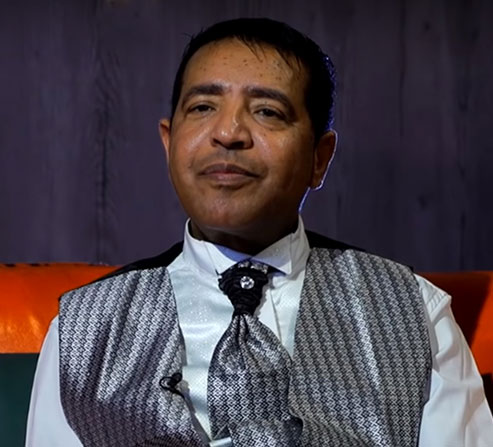
Apr 3 , 2021
The art of melody writing was brought to the forefront by the likes of Abebe Melesse. The younger generation needs to replicate such dedication to melody. With the likes of Rophnan and Kassmasse, there is a real possibility that the Ethiopian music scene will continue to reinvent itself, writes Tadesse Tsegaye (seetadnow@gmail.com), a polyglot with experience in multicultural-cum-institutional settings in resources management.

Recently, one of my friends argued that melody is dying. I counter-argued that it will never die and reminded him of the last time everyone was complaining of melody's demise. It was a time when music that crosses generations was being produced.
It was while I was in college and we were heading to Metekel, the scene of much controversy in the Benishangul-Gumuz Regional State, for a campaign to construct houses under the Dergue. Perhaps from the anxiety of what awaited us there or a foreshock of imminent homesickness, we were all quiet as we embarked on the bus for the trip.
It was a crossing through familiar places, our guide being the great epic novel, Fiqir Eske Meqaber. Some of us boasted that we had read it several times over; thus the route being taken was almost similar. Others competed, arguing that they knew it just as well, for they had heard the audio narration over the national radio.
But it was the bus driver that would give me a memory that I remember vividly to this day. He was a fatherly, heavily-built man who seemed fit for all the vagaries of nature to be endured on the old rugged road. His encouragement, not only about what awaits us from that particular trip but also in life, persists to this day. He gave the life lessons even as he struggled to shift the gears of his old bus.
Eventually, the trip was getting tiring with its long and winding roads. Suddenly, with what looked like a magic wand from the old man, he opened a box from his dashboard, brought out a cassette tape and put it in the car stereo. It turned out to be songs from Theodros Tadesse’s debut album.
The album was a typical blend of traditional tunes with Western instrumentation – a mix that was not necessarily popular with the music industry's main actors then. Yet it prevailed thanks to the perseverance of the lyrics and, of course, the melody.
Today, every time I play the album, I let the melody escape. I pursue it. Breathless, I catch up with it. It flies again; it disappears; it plunges into a chaos of diverse emotions. I catch it again; I seize it; I embrace it with delight. This sums up the life of a great melody dancing with a music enthusiast.
Abebe Melesse was one of the most prolific melody writers that would create this holy dance. The various songs from his repertoire evidence his very close knowledge and ability to mimic local singers’ vocal timbers to develop tonal combinations fit to each of them. His efforts are recognised through a highly commendable accolade – an honorary doctoral degree from Bahir Dar University.
Given his vigour, not only does much continue to be expected from him, but he has much to teach a future generation of melody makers and lyricists. Most importantly, his melodies live to this day, whistled by people in the streets and reproduced and remixed by musicians.
With the likes of the equally impressive Yilma Gebreab, he has shown that songs have the power to transcend. Some of Abebe’s melodies, with Yilma’s lyrics, and the seemingly effortless vocalisation of the likes of Theodros are what make trips to Metekel, or any significant moment during youth, tolerable.
The younger generation needs to replicate the dedication to melody, contributions to music’s commercialisation, and the hard work, enthusiasm and respect for the art. As to my friend, who was worried that melodies are dead, I invite him to listen to Rophnan’s combination of traditional beats with techno or Kassmasse’s mix of Ambassel vocals with hip-hop. Melody lives on.
PUBLISHED ON
Apr 03,2021 [ VOL
22 , NO
1092]


Radar | Sep 28,2019

My Opinion | Jan 23,2021

Sunday with Eden | Dec 07,2024

My Opinion | Jul 27,2024

Films Review | Mar 02,2019

Editorial | Sep 27,2020

Commentaries | Jan 07,2024

Commentaries | Oct 02,2021

Fortune News | Jun 01,2019

Fortune News | Dec 01,2024

Dec 22 , 2024 . By TIZITA SHEWAFERAW
Charged with transforming colossal state-owned enterprises into modern and competitiv...

Aug 18 , 2024 . By AKSAH ITALO
Although predictable Yonas Zerihun's job in the ride-hailing service is not immune to...

Jul 28 , 2024 . By TIZITA SHEWAFERAW
Unhabitual, perhaps too many, Samuel Gebreyohannes, 38, used to occasionally enjoy a couple of beers at breakfast. However, he recently swit...

Jul 13 , 2024 . By AKSAH ITALO
Investors who rely on tractors, trucks, and field vehicles for commuting, transporting commodities, and f...

Oct 25 , 2025
The regulatory machinery is on overdrive. In only two years, no fewer than 35 new pro...

Oct 18 , 2025
The political establishment, notably the ruling party and its top brass, has become p...

Oct 11 , 2025
Ladislas Farago, a roving Associated Press (AP) correspondent, arrived in Ethiopia in...

Oct 4 , 2025
Eyob Tekalegn (PhD) had been in the Governor's chair for only weeks when, on Septembe...